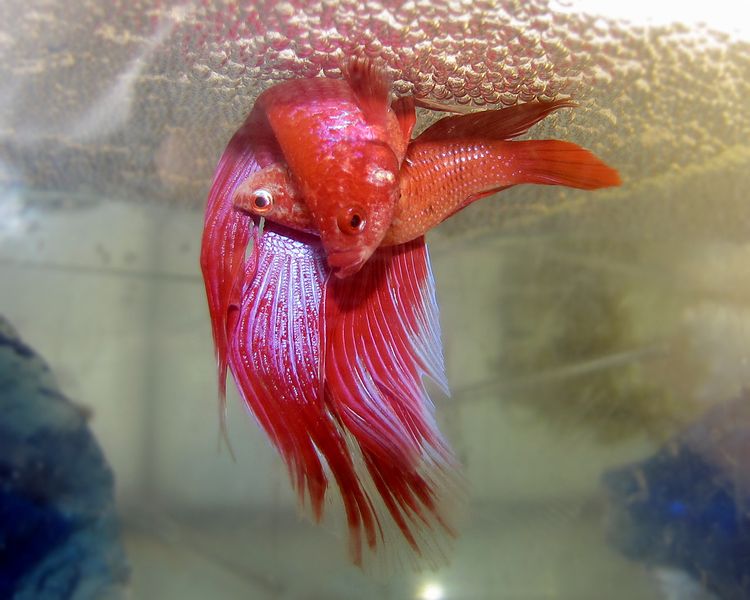Hello, Frank Indiviglio here. In terms of species diversity, fishes are the most successful of all vertebrates…with over 25,000 species identified so far, they outnumber mammals, reptiles, amphibians and birds combined. Ranging in size from 2/5 of an inch to over 40 feet in length, one fish or another has colonized every aquatic habitat imaginable, from desert pools of 104 F in temperature to frigid Antarctic seas.
In keeping with this remarkable diversity, fish reproductive methods are also extremely varied. Today I’d like to convey some interesting facts concerning the breeding habits of both aquarium and non-pet trade species.
Placing the Young out of Harm’s Way
 All American and European eels, whether inhabiting a bay in New Jersey or a pond in England, originated as eggs laid in the Sargasso Sea, off Bermuda. Eels, salmon and many other fishes engage in massive breeding migrations, with millions of adults laying eggs simultaneously and then dying shortly thereafter.
All American and European eels, whether inhabiting a bay in New Jersey or a pond in England, originated as eggs laid in the Sargasso Sea, off Bermuda. Eels, salmon and many other fishes engage in massive breeding migrations, with millions of adults laying eggs simultaneously and then dying shortly thereafter.
Most fishes lay eggs (up to 35 million per season in some cases), but a great many are live bearers that reproduce via internal fertilization. Many merely scatter the eggs or fry and leave them to take their chances, while others take great precautions in preparing nests, guarding the eggs and caring for the young.
Adult tilapia and many others protect their young by taking them into their capacious mouths at the slightest hint of danger, while male bullhead catfish accompany their offspring on feeding forays for several weeks (please note the photo of a brooding Cyphotilapia frontosa – youngsters can be seen within the parent’s mouth). Perhaps most surprising of all, discus fish produce unique skin secretions that serve as food for their fry.
Switching Sexes and Sex Roles
Many fishes depart radically from what we’ve come to know as “typical” vertebrate reproduction. Female seahorses, for example, deposit their eggs in the pouches of the males. The males then act as “surrogate mothers” – regulating the salinity of the water in the pouch, brooding the eggs, and bringing forth the young.
Wrasses, many species of which are kept by marine aquarists, begin life as females, with a number becoming males at a later point, a phenomenon known as protogyny.
The ever-popular clownfishes utilize an equally unusual reproductive strategy, known as protandry. All clownfishes fishes start out as males, and some later change their sex and wind up as females.
Cloning (with a twist)
The Amazon Molly (Poecilia formosa) adds yet another variable to its reproductive strategy. Named for the female-only Amazon Tribe of Greek Mythology (it ranges from southern Texas to northern Mexico, and is not found in the Amazon River), only females are known. They must, however mate with a male to stimulate egg development – but there are no male Amazon Mollies.
Female Amazon Mollies solve this dilemma by mating with males from one of several related species that share their habitat. None of the “father’s” genetic material makes it into the young mollies however – these are all clones of their mother!
Well, we could go on for pages…I’ll add other interesting tidbits in the future. Until then, please write in with your own odd facts and any questions you may have.
Further Reading
To learn why inbreeding has not doomed the Amazon Molly to extinction, please see this article.
To read more about seahorse reproduction, please see my article The Care and Natural History of Native Seahorses.
Thanks, until next time,
Frank Indiviglio
Mouthbrood image referenced from wikipedia and originally posted by MidgleyDJ photo by Matthew Miller
 What could be more exciting for an aquarist than seeing a pair of fish spawn or finding a mass of eggs in the tank? Many beginner aquarists may not realize that their fish have formed a pair, what the fish are doing if they show a courtship ritual or that they are preparing an area to lay thier eggs. When eggs or babies appear, someone new the game may have lots of questions and concerns about what (if anything) they need to do for a successful hatch or to raise the fry.
What could be more exciting for an aquarist than seeing a pair of fish spawn or finding a mass of eggs in the tank? Many beginner aquarists may not realize that their fish have formed a pair, what the fish are doing if they show a courtship ritual or that they are preparing an area to lay thier eggs. When eggs or babies appear, someone new the game may have lots of questions and concerns about what (if anything) they need to do for a successful hatch or to raise the fry. That Fish Blog – Aquarium Advice and Information
That Fish Blog – Aquarium Advice and Information

 All American and European eels, whether inhabiting a bay in New Jersey or a pond in England, originated as eggs laid in the Sargasso Sea, off Bermuda. Eels, salmon and many other fishes engage in massive breeding migrations, with millions of adults laying eggs simultaneously and then dying shortly thereafter.
All American and European eels, whether inhabiting a bay in New Jersey or a pond in England, originated as eggs laid in the Sargasso Sea, off Bermuda. Eels, salmon and many other fishes engage in massive breeding migrations, with millions of adults laying eggs simultaneously and then dying shortly thereafter.